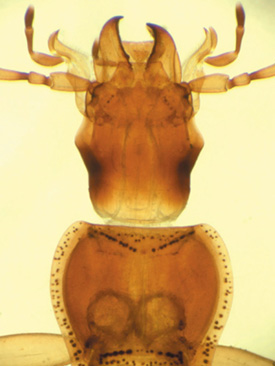 Citations
Citations
An
aspirin a day keeps the polyps away
When Chicago researchers and their colleagues saw how well
aspirin helped to prevent new polyps in colorectal cancer
survivors, they decided to stop their multicenter study
after three years, about one year early, so the public could
begin taking advantage of the findings. Published in the
March 6 New England Journal of Medicine, the study
showed that only 17 percent of patients who took 325 milligrams
of aspirin a day developed new polyps—and the ones
who did had fewer tumors than the placebo patients. Senior
author and professor of medicine Richard
Schilsky, MD’75, who chairs the national Cancer
and Leukemia Group B research organization, which spearheaded
the study, said that while many doctors already recommend
aspirin to prevent cardiovascular disease, this research
suggests one more reason to do so. The best dosage, however,
has not yet been determined.

Mark Westneat, courtesy the Field Museum |
| Tracheal tubes compress
and expand in this beetle x-ray. |
Breathing
bugs
Many insects breathe in a manner similar to humans. That’s
according to researchers at Argonne National Laboratory
and the Field Museum, who used a new technology to observe
movement inside living bugs. Mark
Westneat, Chicago biology lecturer and the Field
Museum’s associate curator of zoology, writes in the
January 24 Science that in addition to the passive
breathing mechanisms insects use to slowly exchange oxygen
through their tracheae, bugs such as beetles, crickets,
ants, butterflies, cockroaches, and dragonflies also rapidly
compress and expand the tracheae in their heads and thoraxes.
Some species exchange as much as half of the air in their
main tracheal tubes every second, about the same rate as
a person exercising moderately. The scientists viewed the
bugs with Argonne’s Advanced Photon Source synchrotron,
which generates radiation more than 1 billion times stronger
than a conventional x-ray.
Back
when the cosmos was young
Scientists have unveiled the earliest image of the universe
ever seen, 380,000 years after the Big Bang and 200 million
years before stars and galaxies formed. The image, taken
by NASA’s Wilkinson Microwave Anisotropy Probe (WMAP),
shows a detailed portrait of the cosmic microwave background,
the Big Bang’s afterglow. It sets the universe’s
age at 13.7 billion years, with a 1 percent margin for error—the
most accurate estimate to date. The image also supports
the theory that the universe is expanding, pushed apart
by “dark energy,” which, according to the probe,
makes up 73 percent of the universe, compared to 23 percent
dark matter and 4 percent atoms. Astronomy & astrophysics
professor Stephan Meyer, a
member of the probe’s science team, presented the
results at a special seminar February 12 at the Biological
Sciences Learning Center, while NASA simultaneously announced
the results at a Washington press conference.
Varying
degrees of health care
Millions of U.S. patients with chronic diseases receive
subpar physician care, largely because physician groups
follow on average only five of 16 recommended care-management
processes, such as using nurse care managers to maintain
contact with patients and teaching patients to care for
their illnesses at home. In a January 22 Journal of
the American Medical Association study of 1,040 medical
groups and independent practices,
Lawrence Casalino, assistant professor of health
studies, focused on the treatment of asthma, congestive
heart failure, depression, and diabetes. Doctors are more
likely to use recommended processes, he said, when they
have better technology and are given external incentives,
such as financial rewards or better health-plan contracts.
—A.B.


![]() Advertising
Advertising
![]() About
the Magazine
About
the Magazine ![]() Alumni
Alumni
![]() UChicago
UChicago
![]()
![]() ©2003 The University
of Chicago® Magazine
©2003 The University
of Chicago® Magazine ![]() 5801 South Ellis Ave., Chicago, IL 60637
5801 South Ellis Ave., Chicago, IL 60637![]() fax: 773/702-0495
fax: 773/702-0495 ![]() uchicago-magazine@uchicago.edu
uchicago-magazine@uchicago.edu
